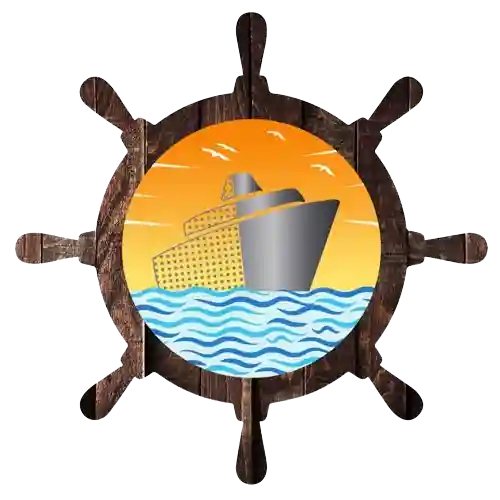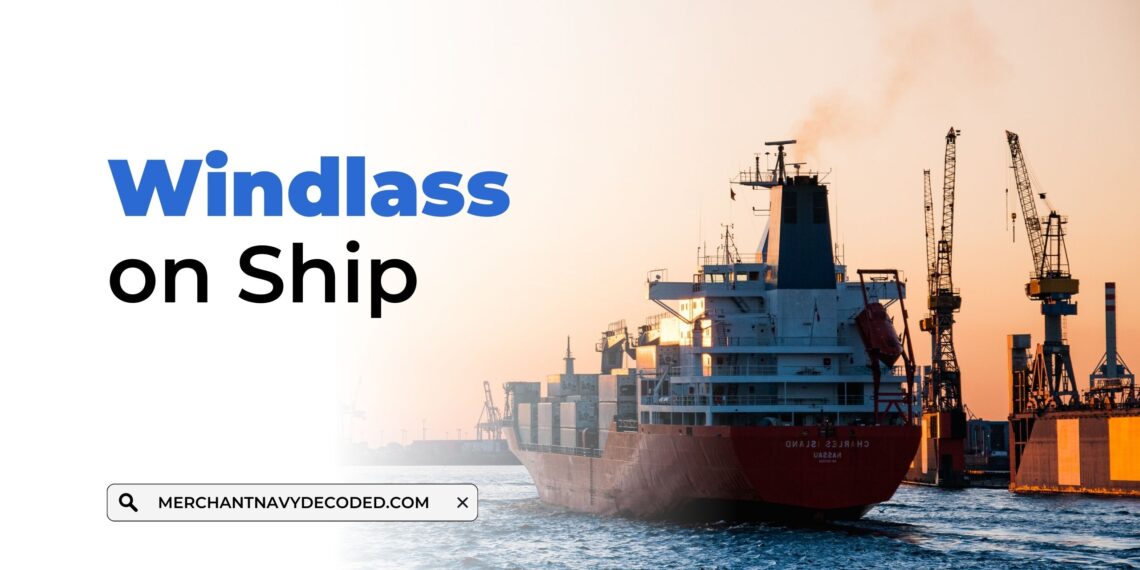Windlass on Ship
The mechanical gear machine aboard a ship that raises and lowers anchors with heavy metal chains connected is called a windlass. The primary objective of Windlass is to securely and effectively anchor a ship, which is crucial for navigating. The Windlass system uses a series of reduction gears to transmit torques that are critical to the cable lifter to raise or release the enormous weight of the anchor and chain.
To handle the enormous stresses used during anchoring, the windlass is equipped with extra structural improvement elements such as deck girders, doubler plates, and supporting pillars atop a sturdy, structurally reinforced foundation.
In the modern windlass system, the windlass and the forward mooring winch are often included as a single unit, ensuring versatility in handling both mooring and anchoring tasks. This guarantees the system’s robustness and dependability even in the face of extreme strain.
1: Where is the Windlass Located on a Ship?
The windlass is located at the fore end of big ships, including oil tankers or container ships, usually in a place known as the windlass room or chamber. To enhance accessibility and operating space, as well as to increase safety and decrease accidents, many ships install windlasses on the forecastle deck.
1.1: Benefits (pros) of a Deck-Mounted Windlass
Due to its deck location, the windlass makes anchoring procedures easier to perform. Also, it frees up room within the spacecraft, which may be used to store a valuable resource on board. When it comes to manual or semi-manual windlass systems, putting the windlass on deck guarantees that crew members can operate the windlass more quickly in an emergency.
1.2: Challenges (Cons) of Deck Placement
Despite its benefits, a deck-mounted windlass is subject to the weather, which raises questions regarding its endurance (rusting and other operational issues might be caused by the action of seawater).
Potential hazards to the forecastle deck include bow slamming, which occurs when the ship’s bow crashes into the ocean during choppy seas, and green water loading, which is the pounding and panting of big waves washing over the deck. The windlass and its parts may be damaged by these forces. Also, an exposed windlass system on deck might make it difficult for crew members to maneuver, which could be risky.
2: Windlass Systems for Different Vessel Sizes
- Smaller vessels (usually under 30 feet) typically do not require a windlass since their anchors are light.
- Medium-sized vessels (from 30 to 100 feet) frequently employ a single windlass system to manage anchors on both the port and starboard sides.
- Larger ships (larger than 100 feet) require precision, hence a split windlass system is used, with separate machinery managing anchors on either side. This unique design allows for simple transportation in ports and when anchoring at sea.
This brings us to another topic that you might wanna read i.e. Types of Ship.
3: Electrically Operated Windlass
The electrically operated windlass is an essential component of ship mooring and anchoring equipment. Electrically operated windlass, which is commonly used in combination with mooring winches, employs a two-speed motor with a pole-changing system to properly adjust torque and speed.
3.1: Functionality of electrically operated windlass
- The windlass contains an electrical two-speed motor that can operate at both low and high speeds. By offering a higher torque for up to 30 minutes roughly 150% of the total continuous torque the low-speed mode successfully loosens the anchor’s hold on the ocean floor.
- The high-speed option, on the other hand, is meant to make maneuvering mooring lines or lowering the anchor easier. A double-reduction gearbox’s oil-lubricated, machine-cut gears operate smoothly and effectively at both speeds.
- To prevent unexpected strain on the system, the windlass has an overload slip clutch that disconnects the drive in the event of an overload. Electrical safety cuts are also available, albeit in some circumstances they might not be as sensitive. It is perfect for smaller boats with low operational needs because of its smaller size and simpler design.
3.2: Limitations of using Electrically operated Windlass
- Restricted Usage: These systems are better suited for small ships due to their limited torque and speed range compared to hydraulic systems.
- Overload Sensitivity safety of the windlass: Electrical components may fail to manage sudden overloads as efficiently as hydraulic systems.
4:- Hydraulically Operated Windlass
The hydraulically operated windlass is the preferred choice for larger vessels due to its superior torque capabilities and robust construction.
4.1: Features and Benefits of using Hydraulically operated windlass
- High Torque at Low Speeds: Hydraulic motors are capable of producing significant torque at speeds as low as 5–10 RPM. They are therefore perfect for releasing the anchor’s grip on the ocean floor.
- Simplified Construction: Hydraulic windlasses, as opposed to electrical systems, do not require slip clutches or reduction gearboxes, which lowers maintenance requirements and expenses.
- Sturdy and Robust: Hydraulic systems are more dependable in challenging circumstances because they can tolerate large shocks and hard treatment.
- Safety Procedures: When required, a spring-loaded shock valve transfers high pressure to the low-pressure side, preventing system overload.
4.2: Operation of Hydraulically Operated Windlass
A range of control settings allows the windlass to perform several tasks efficiently. The control block is built with many operational positions to meet different needs. Position 1 is used for the anchor’s normal lifting, whereas position 2 provides a lot of torque to break the anchor hold. By reversing the motor’s direction, the “R” option enables the anchor to walk back.
5: Rotor Design in Windlass Motors
Strong discs with rectangular vanes are a defining characteristic of hydraulic windlass rotors. These vanes have springs that keep the pressure against the housing constant, guaranteeing efficient performance. A reliable driving component for gear pumps, the double-squirrel cage rotor used in electric motors provides substantial slip capacity and enhanced current management.
Owners of ships may choose the best windlass arrangement to suit the unique requirements of their vessel by having a thorough awareness of the many benefits and limitations connected to these systems.
6: Classification Rules of Windlass Components on Ship
| Component | Requirements/Specifications |
| Windlass Power | – Strong enough to handle the size of the anchor chain. – Winches with wire rope control are needed if using wire ropes instead of chain cables. |
| Cable Lifters | – Each anchor should have its cable lifter. – Lifter connected to the driving shaft by a release coupling. – Lifter must have a brake. |
| Chain Stopper | – Should be between the windlass and Hawse pipe. – Chain cable should only pass via cable lifter and into the hawse pipe. |
| Electric Windlasses | – Need a torque-limiting device (slip clutch). – Electric motors must meet specific specifications (Part 4, Chapter 8). |
| Windlass Capacity | – Must pull continuously for 30 minutes, depending on chain diameter. – Specifications based on chain grade: – 36.8 dc for CC1 grade chain. – 41.7 dc for CC2 grade chain. – 46.6 dc for CC3 grade chain. |
| Hoisting Speed | – Must be no less than 9 meters per minute. |
| Windlass Pulling Strength | – Must exert 1.5 times its continuous duty pull for 2 minutes, speed may be slower. |
| Windlass Brake Capacity | – Brake must safely stop the anchor and chain cable while paying out. – Must withstand 45% of the chain’s breaking strength if using a release coupling. – If no chain stopper, it should withstand 80% of breaking strength. |
| Chain Stoppers | – Should withstand 80% of the chain’s breaking strength without causing long-term damage. – Must provide even support for the chain links. |
| Stress Considerations | – Pay attention to stress concentrations, especially in areas like keyways where the anchor chain may experience rapid stress during starts/stops. |
7: Windlass Frequently Asked Question
- What is the difference between a windlass and a winch?
- A windlass is typically used to lift and drop the anchors of the ship while a winch is used to wind up or wind out the ropes.
- What is the purpose of windlass and mooring winch?
- The main function of the windlass is for raising and lowering the ship’s anchor, whereas the mooring winch is used to hold the ship while mooring.
- What type of chain is used for windlass?
- Grade 2 or Grade 3 metal chains are generally used in windlass.
- What are the 2 types of ways through which windlass can be operated?
- The windlass is generally used hydraulically or electrically in all modern ships.
Disclaimer :- The opinions expressed in this article belong solely to the author and may not necessarily reflect those of Merchant Navy Decoded. We cannot guarantee the accuracy of the information provided and disclaim any responsibility for it. Data and visuals used are sourced from publicly available information and may not be authenticated by any regulatory body. Reviews and comments appearing on our blogs represent the opinions of individuals and do not necessarily reflect the views of Merchant Navy Decoded. We are not responsible for any loss or damage resulting from reliance on these reviews or comments.
Reproduction, copying, sharing, or use of the article or images in any form is strictly prohibited without prior permission from both the author and Merchant Navy Decoded.




